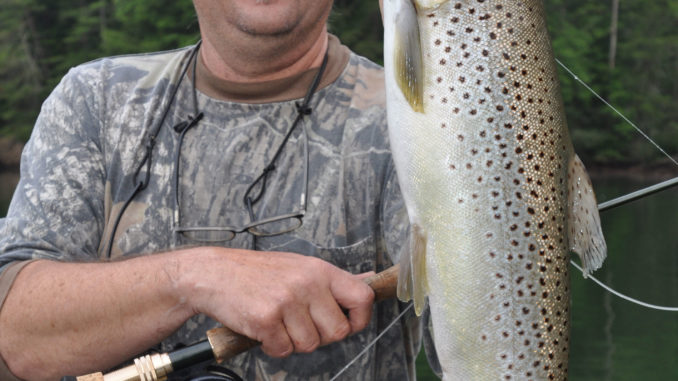
Apalachia Lake is about as far west as you can go in North Carolina, and an experimental trophy trout fishery might make it well worth the drive.
A summer Saturday with a nice weather forecast finds nearly every lake in North Carolina packed with anglers; arriving before daybreak is a prerequisite to having a place to park a boat trailer and tow vehicle at most public ramps.
But last June 25, only one boat was launched at the N.C. Wildlife Resources Commission’s ramp on Apalachia Lake. Sliding his 18-foot aluminum johnboat into the 1,070-acre lake was David Woody, a conservation technician with the commission in western North Carolina.
Apalachia Lake is so remote that few anglers visit. Only a few houses dot its shoreline west of Murphy, N.C., and it’s as far west as boaters can travel and still be in North Carolina; the lake nearly touches Tennessee. Until the past couple of years, it had a lackluster reputation as a place to catch smallmouth bass and sunfish, so even local anglers headed for Lake Hiwassee.
Heading down the narrow, run-of-the-river lake, snaking along between mountain peaks, Woody stopped when he saw a fish break the surface. Picking up his fly rod, he wet the line with a false cast, and a fish broke behind his boat. He turned and shot his fly into the boil. It took only two strips of line before he set the hook into a monstrous brown trout.
He played the fish until it was exhausted and dipped it from the crystal-clear water with a landing net. He was still shaking with excitement when he put the trout in a measuring tray and weighed it on a digital scale.
“Sixty-two centimeters, which is about 24.4 inches long,” Woody said. “It weighs 5 pounds, 10 ounces. This is the biggest brown trout I have caught from Apalachia Lake.”
Giving the fish a better look, he found a red patch behind its right eye; the discovery was almost as exciting as catching the trophy fish.
“I probably held this fish in my hands when it was stocked four years ago,” he said. “The first year, we marked each fish, with a red elastomer tag in the right cheek of the larger fish and in the left cheek of the smaller fish. This one was one of the larger fish and was around 14 inches long when it was stocked.”
Any brown or rainbow trout 18 inches long or weighing at least 2 pounds, 8 ounces is large enough to earn a certificate for an outstanding catch through the Commission’s North Carolina Angler Recognition Program. While fish of that size are rare in most mountain waters, producing such large fish is the goal of the Commission’s trophy trout stocking experiment at Apalachia.
Amanda Bushon, the Commission’s district fisheries biologist for western North Carolina, has been shepherding Apalachia’s trophy trout fishery since its inception.
“The idea came from a similar management program at Lake Jocassee (South Carolina) that is the shining example of what you can do with a lake that has abundant forage and good habitat,” Bushon said. “Blueback herring showed up in Lake Hiwassee in 1998. They are popular baitfish for striped bass, which we now stock in Hiwassee, and (they) probably came from a live-bait tank. The herring probably moved downstream into Apalachia within the next couple of years. Apalachia is so remote we had not actively managed it until we started this trophy trout project.”
The creation of the fishery is a case of using sour lemons to make lemonade. The blueback herring caused a reduction in reproduction and recruitment of walleye in Hiwassee. Stripers stocked in Hiwassee created a new fishery based on the newly arrived herring. The rainbow and brown trout the Commission stocked into Apalachia Lake have also taken advantage of the new forage species.
While there were initially a few wild rainbow trout swimming in Apalachia Lake, they had not shown up on many anglers’ radar until the Commission stocked approximately 1,500 10-inch and 1,000 14-inch rainbow trout — and about the same numbers and sizes of brown trout — from 2012 through 2015. The cheek tags were red in 2012, blue in 2013, yellow in 2014 and orange in 2015. Commission personnel also implanted a metal tag, detectable with a metal detector, into the opposite cheek. If, over time, the color of the tag fades, the metal tag will confirm that a trout was raised in a hatchery and stocked into the lake.
Besides abundant forage, trout must have cold water with a high level of dissolved oxygen. The water in Apalachia comes through Hiwassee Dam, from the bottom of the lake, its temperature in the low 50s — cold enough for good trout survival and growth rates. The licensing agreement with the Tennessee Valley Authority requires its power plant to oxygenate the water it discharges through the dam.
Apalachia is a deep, 9.8-mile lake with a dam height of 150 feet, but the Commission’s electrofishing boats and gill nets can only sample fish in shallow areas, so data on the growth and abundance of the stocked trout is limited. Angler surveys, which supplement the sampling data, show that approximately 12 percent of angler catch is brown trout, and eight percent is rainbow trout. Anglers’ primary catches consist of smallmouth and largemouth bass, with some yellow perch and sunfish in the mix.
“The rainbow trout are not growing as well as the brown trout, although one angler caught a rainbow trout that weighed 3.78 pounds.” Bushon said. “In our electrofishing surveys, we have caught 19-inch rainbow trout that weighed 3.5 pounds and a brown trout that weighed 10 pounds. Anglers have reported catching brown trout that weighed 12 pounds.”
Bushon said anglers are catching onto catching the lake’s big brown trout, many by casting or trolling lures. Woody, however, is a dedicated fly-fisherman.
“If you want to catch a big brown trout, you should use a fly that looks like a herring,” Woody said. “I use a white streamer fly. The fish were finicky today; I only saw four fish following my fly and hooked one. The most I’ve ever caught in one day was 14, but you can also get skunked.”
Woody said he is one of the few fly-fishermen who loves fishing Apalachia Lake. He is only after big trout, not big numbers, and the odds of catching a big one are high. He fishes the lake once or twice a month during warm weather, and his hookup-to-strike ratio is about 5-to-1 because the big browns are difficult to keep on the hook.
To find fish, he launches at dawn and begins searching for signs of feeding fish. The trout run the herring to the surface for about the first two hours of daylight before heading for deep water.
“I cast to the fish, and he usually hits it right off if he is hot,” he said. “A brown trout is an eating machine; if your fly looks like an injured herring, he is going to take it. A successful hookup and fight that leads to a landed fish usually takes four or five minutes. The important thing is using the reel’s drag during the fight, because the reel is mechanical, not emotional. If you use your fingers, you may apply too much pressure and the hook will pull free or you may not use enough pressure with the same result.”
DESTINATION INFORMATION
HOW TO GET THERE — I-40 will get anglers from most parts of North Carolina into the neighborhood of Apalachia Lake. From US 64/74 and NC 294 south of Murphy, take NC 294 west, turning right on TVA Hiwassee Dam Access Rd (SR 1314), then turn left on Powerhouse Road to the access area, which is at 555 Powerhouse Rd., Murphy.
WHEN TO GO — Trout bite year-round. The best months for topwater and fly fishing are June and July. The best months for trolling are February and March.
BEST TECHNIQUES — The best flies are large streamers that resemble blueback herring: Maribou streamers or Popsicles. The best lures also resemble herring, with Rapala and Rebel minnows, Lucky Craft Pointer, Bass Assassin and Kastmaster spoon good choices. When fly fishing, a 9-foot, 7-weight rod and 7/8 weight reel spooled with an intermediate sink tip or full sinking line.
FISHING INFO/GUIDES — Southern Appalachian Anglers, 828-691-1506, www.southernappalachiananglers.com. See also Guides and Charters in Classifieds
ACCOMMODATIONS — Days Inn, Murphy, 828-837-8030. Econo Lodge, Murphy, 828-837-8880.
MAPS — DeLorme North Carolina Atlas and Gazetteer, 800-452-5931 or www.delorme.com.

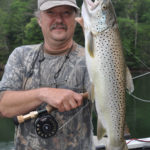
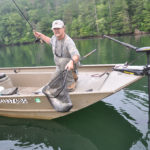
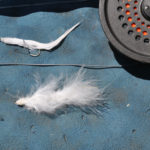
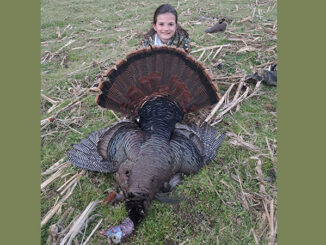



Be the first to comment